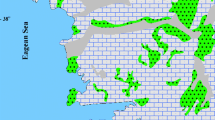Abstract
In the marbel industry, ore reserves refer to the produced tonnage of orthogonal prismatic, defect-free blocks of commercial sizes and of marketable aesthetical quality. On the contrary, in the mining sector, ore reserves refer to the tonnage of ore with grade above some cut-off value. While in the mining sector ore reserves are reported according to existing standard guidelines, the marble industry has no standard method. The purpose of this paper is to present a method to estimate white marble reserves using drill coring or borehole wall logging and limited joint mapping on exposed marble surfaces. Data pertaining to fracture orientation, fracture frequency, size, and whiteness were collected. The primary phase of marble characterization is followed by the discretization of the orebody into a three-dimensional array of orthogonal prismatic blocks, where the marble whiteness and fracture intensity are attribute values. Both these variables are considered to obey continuous and not discrete probability distributions. The discretization is performed using computer aided design and the Block Kriging techniques. An outline to improve the description of a given marble ore deposit at the exploration stage is presented for the prediction of marble block size distribution from joint count measurements along diamond drill cores. An example case of a white dolomitic marble quarry is used to demonstrate these methods.

















Similar content being viewed by others
Abbreviations
- BM:
-
Block model using the Kriging technique
- CAD:
-
Computer aided design
- CIM:
-
Canadian Institute of Mining, Metallurgy and Petroleum
- CL:
-
Confidence level
- CVP:
-
Cumulative volume proportion
- DTM:
-
Digital terrain model
- FF:
-
Fracture frequency (expressed in total number of joints per metre of rock core)
- FF′:
-
Fracture frequency of each joint set (expressed in m−1)
- JORC:
-
Joint Ore Reserves Committee
- MF:
-
Modifying factors in the process of transforming resources to reserves
- NHPP:
-
Non-homogeneous poisson process
- NSD:
-
Normalized standard deviation
- pdf:
-
Probability density function
- PERC:
-
Pan-European Reserves & Resources Reporting Committee
- RR:
-
Recovery ratio
- SR:
-
Stripping ratio
- Wht:
-
Whiteness (expressed in %)
- a :
-
Normalized standard deviation of the prediction at each block of the model
- γ(h):
-
Geostatistical semi-variance function of the lag h
- f λ :
-
Number of fractures per fixed length interval along scanline or rock core (m−1)
- λ :
-
Basic linear frequency parameter of the NHPP
- \( {\sigma}_{OK}^2 \) :
-
Kriging variance at the centroid of each block in the model
References
Itasca (2004) 3DEC, version 3.0. Itasca Consulting Group Inc., Minneapolis
Schanda J (2007) Colorimetry. Wiley-Interscience, Hoboken, p 61
Chiles JP, Delfiner P (1999) Geostatistics—modeling spatial uncertainty. Wiley, New York
Kitanidis PK (1997) Introduction to geostatistics. Cambridge University Press, Cambridge
PERC Reporting Standard (2013) Pan-European standard for reporting of exploration results, mineral resources and reserves, The Pan-European reserves and resources reporting committee (PERC asbl). http://www.percstandard.eu/
JORC (2012) Australasian code for reporting of exploration results, mineral resources and ore reserves, AusIMM, Carlton
CIM Definition Standards - For Mineral Resources and Mineral Reserves (2010) Prepared by the CIM Standing Committee on Reserve Definitions, Adopted by CIM Council on November 27, 2010. http://en.wikipedia.org/wiki/National_Instrument_43-101
GEOVIA Surpac™ Integrated Geology, Resource Modeling, Mine Planning and Production, Dassault Systems (https://www.3ds.com/products-services/geovia/products/surpac/)
Spyridonos E, Prissang R, Manutsoglu E, Exadaktylos G (2003) State-of-the-art 3D modelling techniques: vital tools to ensure the efficient use of non-renewable resources. In: Sustainable development indicators in the mineral industries. Milos, Greece, pp 347–352
Kapageridis I, Albanopoulos C (2018) Resource and reserve estimation for a marble quarry using quality indicators. J South Afr Inst Min Metall 118:39–45. https://doi.org/10.17159/2411-9717/2018/v118n1a5
Elveli B (1995) Open pit mine design and extraction sequencing by use of OR and AI concepts. Int J of Surf Min Reclam Environ 9:149–153. https://doi.org/10.1080/09208119508964741
Dips v6.0 (2016). Graphical and statistical analysis of orientation data. Rocscience. https://www.rocscience.com/software/dips
Abzalov M (2016) Applied mining geology (modern approaches in solid earth sciences), 1st edn. Springer, Cham
Li S, Feng X-T, Li Z, Zhang C, Chen B (2012) Evolution of fractures in the excavation damaged zone of a deeply buried tunnel during TBM construction. Int J Rock Mech Min Sci 55:125–138. https://doi.org/10.1016/j.ijrmms.2012.07.004
Milloy SF, McLean K, McNamara DD (2015) Comparing borehole televiewer logs with continuous core: an example from New Zealand. Proceedings World Geothermal Congress 2015 Melbourne, Australia, 19–25 April 2015, pp 1–6
Williams JH, Johnson CD (2004) Acoustic and optical borehole-wall imaging for fractured-rock aquifer studies. J Appl Geophys 55(1-2):151–159. https://doi.org/10.1016/j.jappgeo.2003.06.009
Isaaks EH, Srivastava RM (1989) An introduction to applied geostatistics. Oxford University Press, Oxford. https://doi.org/10.1016/0098-3004(91)90055-I
Stavropoulou M, Saratsis G, Xiroudakis G, Exadaktylos G (2020) Estimation of fracture spacings distribution from fracture counts along drill cores. Probabilistic Eng Mech
Acknowledgements
The financial support by the Programme “Marble resources estimation based on oriented drill core data (MARBLECORE)” under Contract No. AMΘΡ2-0016310 is kindly acknowledged.
Author information
Authors and Affiliations
Corresponding author
Ethics declarations
Conflict of Interest
The authors declare that they have no conflict of interest.
Additional information
Publisher’s Note
Springer Nature remains neutral with regard to jurisdictional claims in published maps and institutional affiliations.
Rights and permissions
About this article
Cite this article
Exadaktylos, G., Saratsis, G. Methodology for the Estimation and Classification of White Marble Reserves. Mining, Metallurgy & Exploration 37, 981–994 (2020). https://doi.org/10.1007/s42461-020-00228-3
Received:
Accepted:
Published:
Issue Date:
DOI: https://doi.org/10.1007/s42461-020-00228-3




